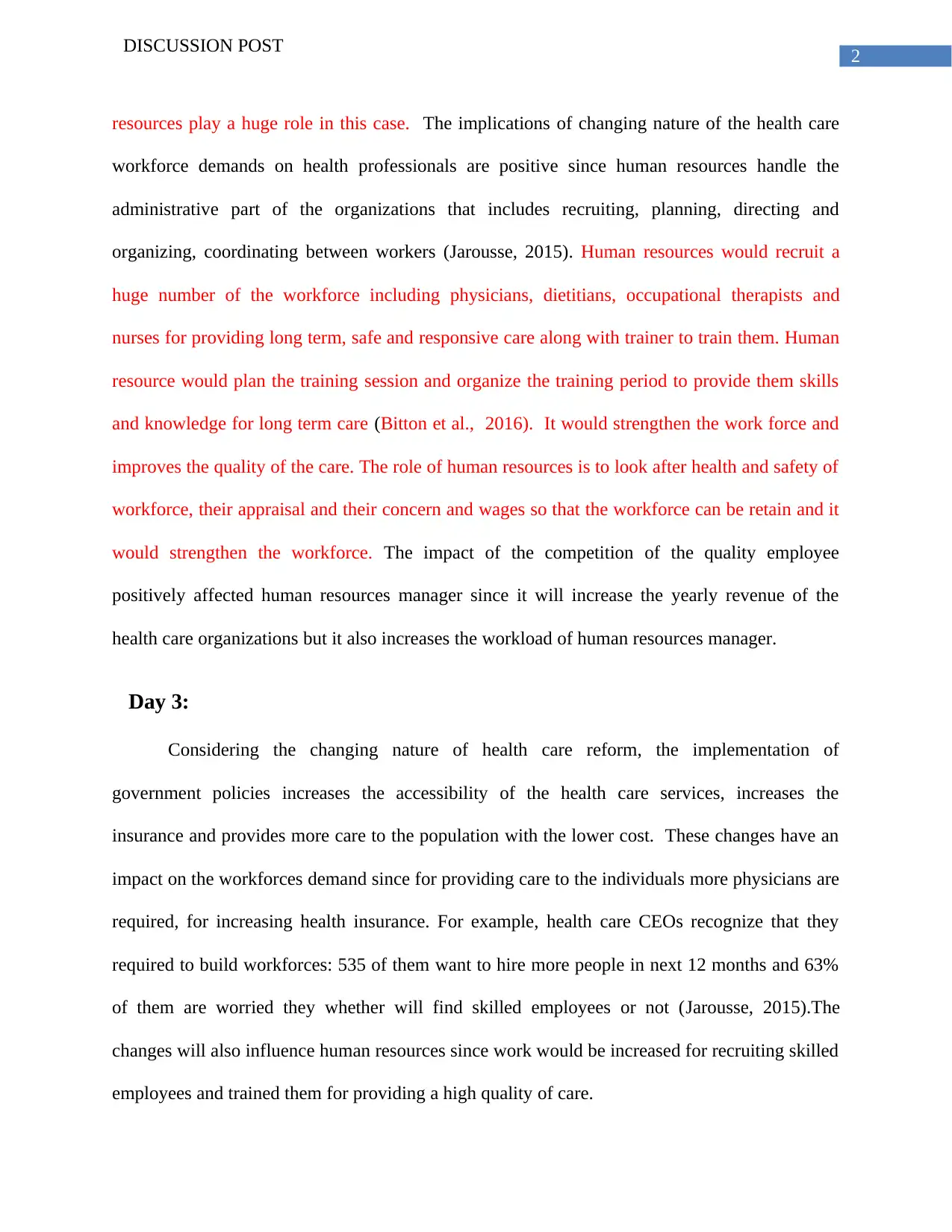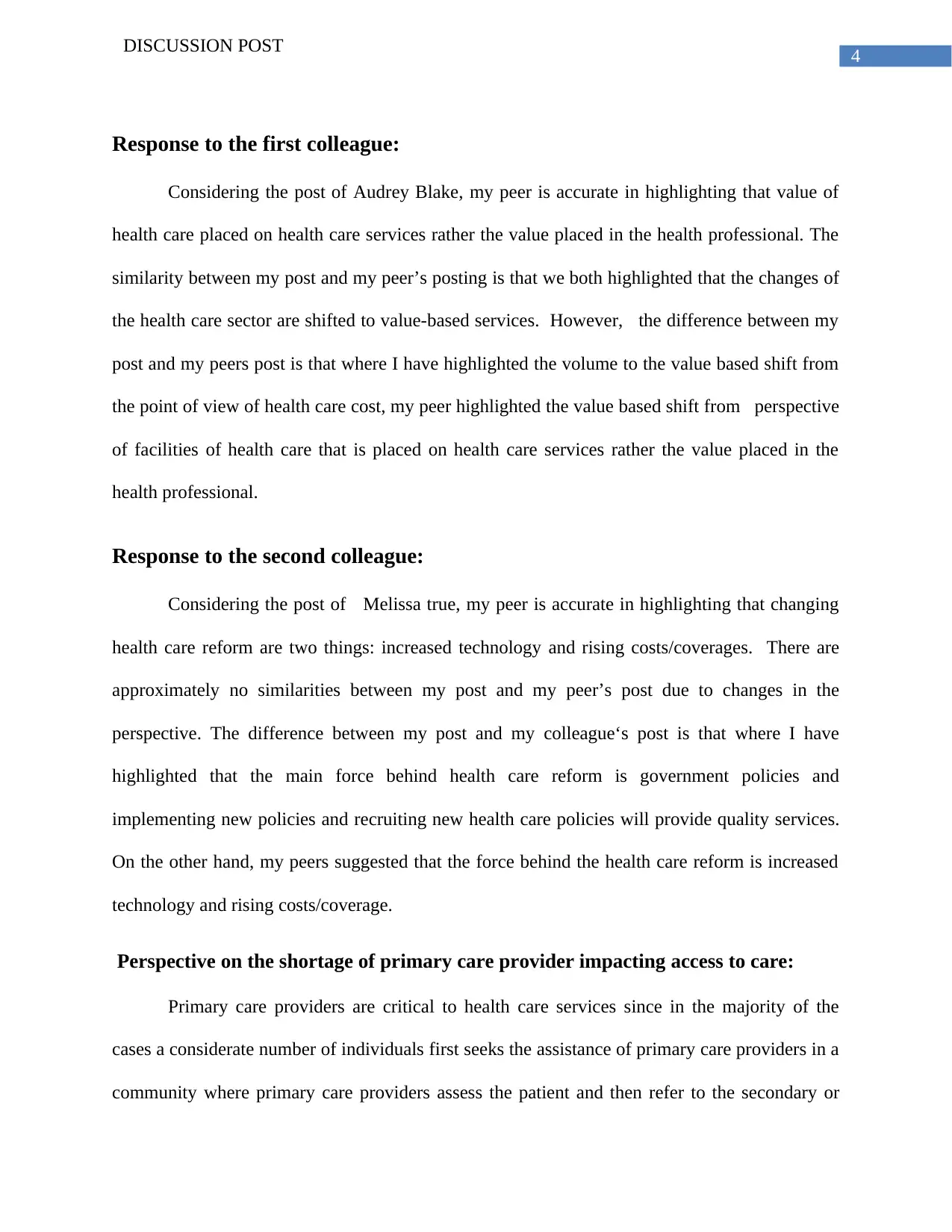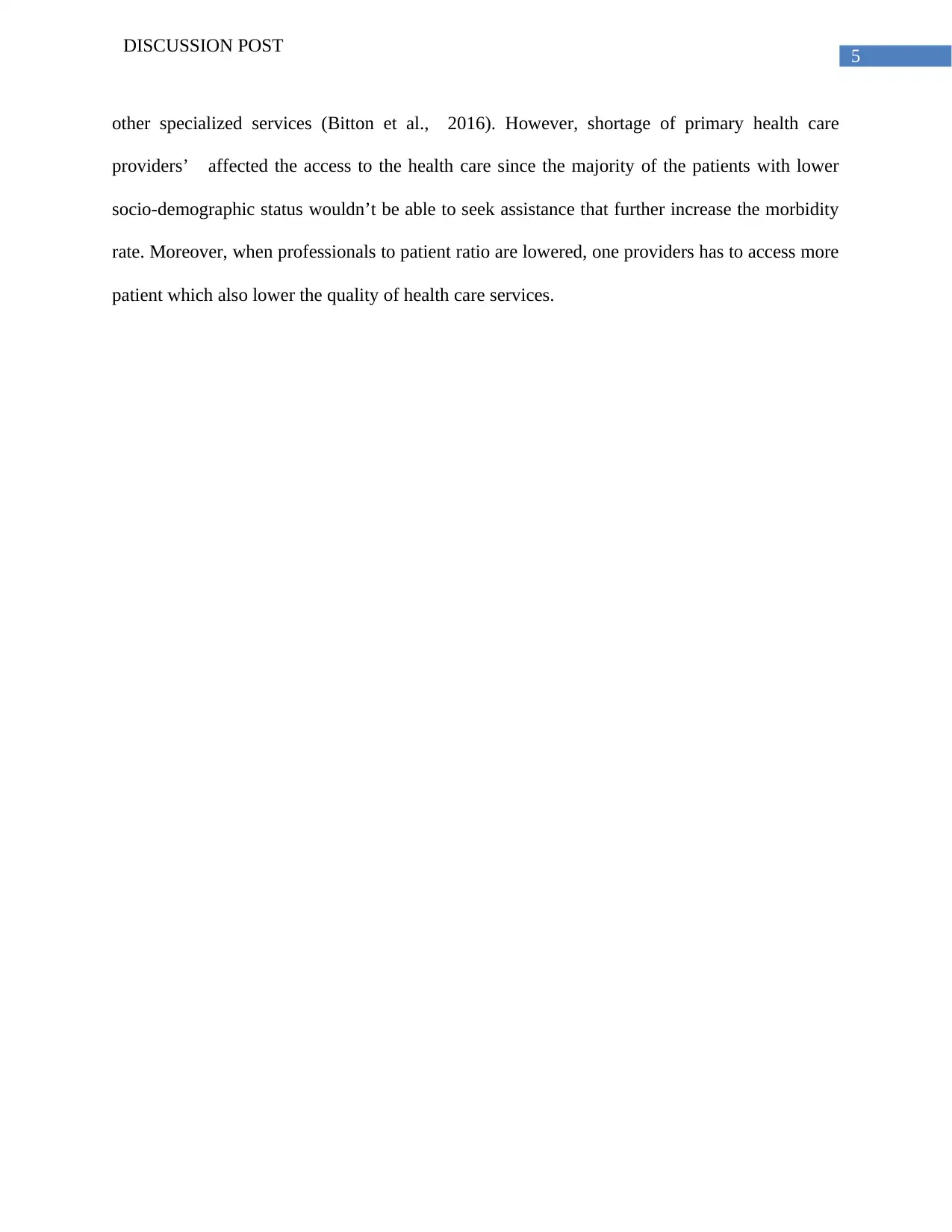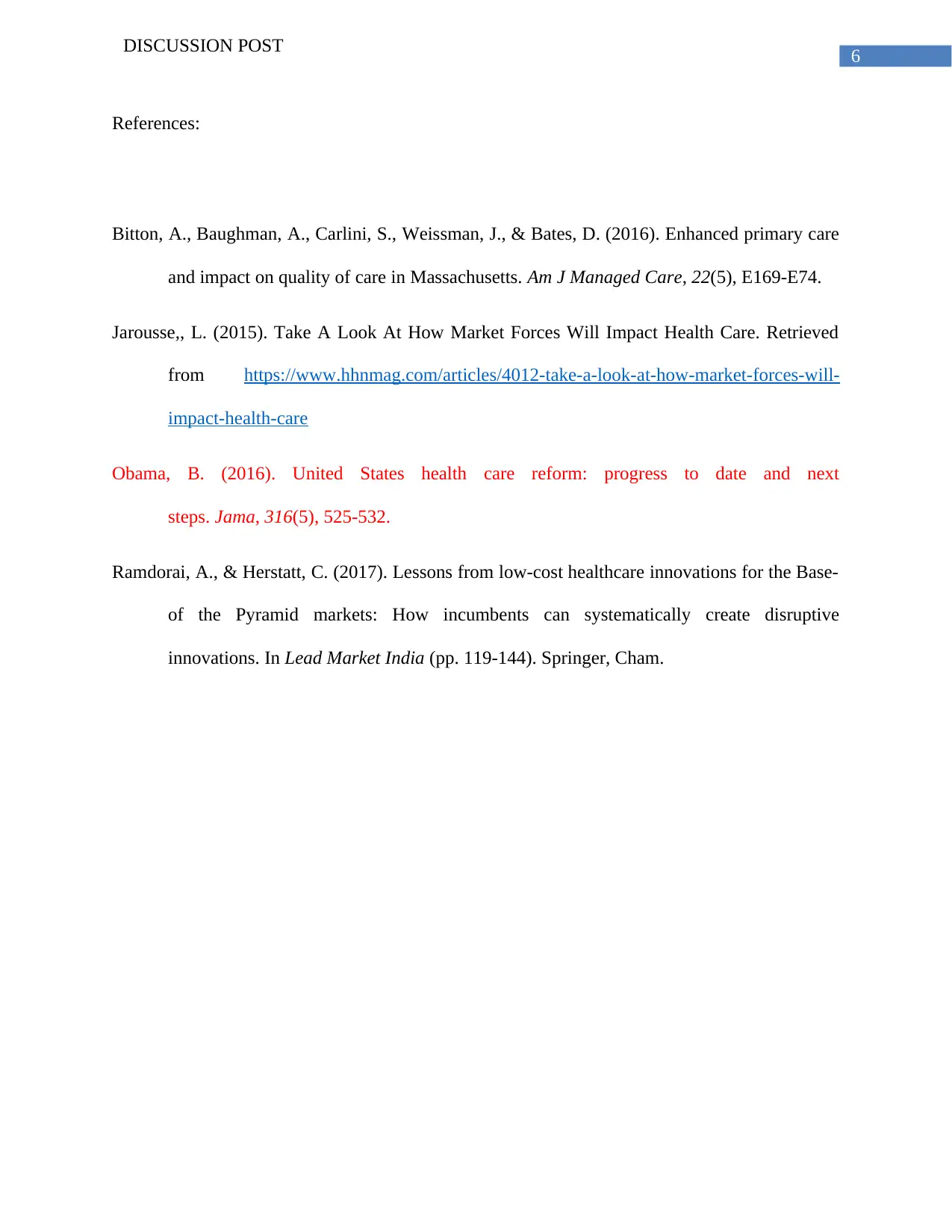Healthcare HR Management: Analyzing Changes Impacting Careers/Access
VerifiedAdded on 2023/04/22
|7
|1276
|426
Discussion Board Post
AI Summary
This discussion post examines the evolving healthcare landscape and its effects on human resources, healthcare careers, and access to care. It highlights the shift towards value-based care, the influence of government policies such as the Affordable Care Act (ACA), and the increasing demand for skilled healthcare professionals. The discussion also addresses the challenges of workforce shortages, particularly in primary care, and the critical role of human resources in recruitment, training, and retention to ensure quality care delivery. Responses to peers focus on differing perspectives regarding the driving forces behind healthcare reform, such as technology versus government policies, and the importance of primary care providers in ensuring access to healthcare services, especially for vulnerable populations. This document is available on Desklib, a platform offering a range of study tools and resources for students.

Running head: DISCUSSION POST
Name of the student;
Name of the university:
Author note:
Name of the student;
Name of the university:
Author note:
Paraphrase This Document
Need a fresh take? Get an instant paraphrase of this document with our AI Paraphraser

1
DISCUSSION POST
Discussion:
The changes in the nature of the health care system not only increased the affordability of
the care but also able to reduce the high expenditure of health care sectors. Considering health
care reforms, implementing the government policies in the health care sectors broaden the
population who receives the health care services through implementing insurance program
improves quality of care and increases accessibility of the health care services involving
specialized practitioner (Jarousse, 2015). Considering volume to value-based transitions, values
defined as giving high quality of the care in lower cost but it was difficult to implement. For
these transitions, the changes in the health care industry enable doctors to provide services at
lower cost and it shifted to value-based payment from fee service payment. In the industry,
where they focus on the culture of excellence, the health care sectors increase price transparency,
increased broadly shared institutional culture to increase gain positive consumer experiences.
(Ramdorai & Herstatt, 2017) The changes mostly affected the health professionals such as nurses
and practitioners along with human resources. The changes increase the demand for health
professionals to provide services and health care chief executive services. Due to the health care
reform, the Patient Protection and Affordable Care Act (ACA) were legislated and impact
directly observed on the workforce, especially the workforce caring for an older patient. The
positive impact of this is that the number of the demand of registered nurse would be increased
palliative care and residential care professionals would be increased and the huge number of
individuals would be employed. On the other hand, the negative impact would be the untrained
workforce. The prime reason behind it is that they lack the requisite knowledge, skills to provide
long term care (Obama, 2016). Moreover, it is difficult to recruit direct care workers because of
the challenging care environment and low wages for the huge number of the patient. Human
DISCUSSION POST
Discussion:
The changes in the nature of the health care system not only increased the affordability of
the care but also able to reduce the high expenditure of health care sectors. Considering health
care reforms, implementing the government policies in the health care sectors broaden the
population who receives the health care services through implementing insurance program
improves quality of care and increases accessibility of the health care services involving
specialized practitioner (Jarousse, 2015). Considering volume to value-based transitions, values
defined as giving high quality of the care in lower cost but it was difficult to implement. For
these transitions, the changes in the health care industry enable doctors to provide services at
lower cost and it shifted to value-based payment from fee service payment. In the industry,
where they focus on the culture of excellence, the health care sectors increase price transparency,
increased broadly shared institutional culture to increase gain positive consumer experiences.
(Ramdorai & Herstatt, 2017) The changes mostly affected the health professionals such as nurses
and practitioners along with human resources. The changes increase the demand for health
professionals to provide services and health care chief executive services. Due to the health care
reform, the Patient Protection and Affordable Care Act (ACA) were legislated and impact
directly observed on the workforce, especially the workforce caring for an older patient. The
positive impact of this is that the number of the demand of registered nurse would be increased
palliative care and residential care professionals would be increased and the huge number of
individuals would be employed. On the other hand, the negative impact would be the untrained
workforce. The prime reason behind it is that they lack the requisite knowledge, skills to provide
long term care (Obama, 2016). Moreover, it is difficult to recruit direct care workers because of
the challenging care environment and low wages for the huge number of the patient. Human

2
DISCUSSION POST
resources play a huge role in this case. The implications of changing nature of the health care
workforce demands on health professionals are positive since human resources handle the
administrative part of the organizations that includes recruiting, planning, directing and
organizing, coordinating between workers (Jarousse, 2015). Human resources would recruit a
huge number of the workforce including physicians, dietitians, occupational therapists and
nurses for providing long term, safe and responsive care along with trainer to train them. Human
resource would plan the training session and organize the training period to provide them skills
and knowledge for long term care (Bitton et al., 2016). It would strengthen the work force and
improves the quality of the care. The role of human resources is to look after health and safety of
workforce, their appraisal and their concern and wages so that the workforce can be retain and it
would strengthen the workforce. The impact of the competition of the quality employee
positively affected human resources manager since it will increase the yearly revenue of the
health care organizations but it also increases the workload of human resources manager.
Day 3:
Considering the changing nature of health care reform, the implementation of
government policies increases the accessibility of the health care services, increases the
insurance and provides more care to the population with the lower cost. These changes have an
impact on the workforces demand since for providing care to the individuals more physicians are
required, for increasing health insurance. For example, health care CEOs recognize that they
required to build workforces: 535 of them want to hire more people in next 12 months and 63%
of them are worried they whether will find skilled employees or not (Jarousse, 2015).The
changes will also influence human resources since work would be increased for recruiting skilled
employees and trained them for providing a high quality of care.
DISCUSSION POST
resources play a huge role in this case. The implications of changing nature of the health care
workforce demands on health professionals are positive since human resources handle the
administrative part of the organizations that includes recruiting, planning, directing and
organizing, coordinating between workers (Jarousse, 2015). Human resources would recruit a
huge number of the workforce including physicians, dietitians, occupational therapists and
nurses for providing long term, safe and responsive care along with trainer to train them. Human
resource would plan the training session and organize the training period to provide them skills
and knowledge for long term care (Bitton et al., 2016). It would strengthen the work force and
improves the quality of the care. The role of human resources is to look after health and safety of
workforce, their appraisal and their concern and wages so that the workforce can be retain and it
would strengthen the workforce. The impact of the competition of the quality employee
positively affected human resources manager since it will increase the yearly revenue of the
health care organizations but it also increases the workload of human resources manager.
Day 3:
Considering the changing nature of health care reform, the implementation of
government policies increases the accessibility of the health care services, increases the
insurance and provides more care to the population with the lower cost. These changes have an
impact on the workforces demand since for providing care to the individuals more physicians are
required, for increasing health insurance. For example, health care CEOs recognize that they
required to build workforces: 535 of them want to hire more people in next 12 months and 63%
of them are worried they whether will find skilled employees or not (Jarousse, 2015).The
changes will also influence human resources since work would be increased for recruiting skilled
employees and trained them for providing a high quality of care.
⊘ This is a preview!⊘
Do you want full access?
Subscribe today to unlock all pages.

Trusted by 1+ million students worldwide

3
DISCUSSION POST
DISCUSSION POST
Paraphrase This Document
Need a fresh take? Get an instant paraphrase of this document with our AI Paraphraser

4
DISCUSSION POST
Response to the first colleague:
Considering the post of Audrey Blake, my peer is accurate in highlighting that value of
health care placed on health care services rather the value placed in the health professional. The
similarity between my post and my peer’s posting is that we both highlighted that the changes of
the health care sector are shifted to value-based services. However, the difference between my
post and my peers post is that where I have highlighted the volume to the value based shift from
the point of view of health care cost, my peer highlighted the value based shift from perspective
of facilities of health care that is placed on health care services rather the value placed in the
health professional.
Response to the second colleague:
Considering the post of Melissa true, my peer is accurate in highlighting that changing
health care reform are two things: increased technology and rising costs/coverages. There are
approximately no similarities between my post and my peer’s post due to changes in the
perspective. The difference between my post and my colleague‘s post is that where I have
highlighted that the main force behind health care reform is government policies and
implementing new policies and recruiting new health care policies will provide quality services.
On the other hand, my peers suggested that the force behind the health care reform is increased
technology and rising costs/coverage.
Perspective on the shortage of primary care provider impacting access to care:
Primary care providers are critical to health care services since in the majority of the
cases a considerate number of individuals first seeks the assistance of primary care providers in a
community where primary care providers assess the patient and then refer to the secondary or
DISCUSSION POST
Response to the first colleague:
Considering the post of Audrey Blake, my peer is accurate in highlighting that value of
health care placed on health care services rather the value placed in the health professional. The
similarity between my post and my peer’s posting is that we both highlighted that the changes of
the health care sector are shifted to value-based services. However, the difference between my
post and my peers post is that where I have highlighted the volume to the value based shift from
the point of view of health care cost, my peer highlighted the value based shift from perspective
of facilities of health care that is placed on health care services rather the value placed in the
health professional.
Response to the second colleague:
Considering the post of Melissa true, my peer is accurate in highlighting that changing
health care reform are two things: increased technology and rising costs/coverages. There are
approximately no similarities between my post and my peer’s post due to changes in the
perspective. The difference between my post and my colleague‘s post is that where I have
highlighted that the main force behind health care reform is government policies and
implementing new policies and recruiting new health care policies will provide quality services.
On the other hand, my peers suggested that the force behind the health care reform is increased
technology and rising costs/coverage.
Perspective on the shortage of primary care provider impacting access to care:
Primary care providers are critical to health care services since in the majority of the
cases a considerate number of individuals first seeks the assistance of primary care providers in a
community where primary care providers assess the patient and then refer to the secondary or

5
DISCUSSION POST
other specialized services (Bitton et al., 2016). However, shortage of primary health care
providers’ affected the access to the health care since the majority of the patients with lower
socio-demographic status wouldn’t be able to seek assistance that further increase the morbidity
rate. Moreover, when professionals to patient ratio are lowered, one providers has to access more
patient which also lower the quality of health care services.
DISCUSSION POST
other specialized services (Bitton et al., 2016). However, shortage of primary health care
providers’ affected the access to the health care since the majority of the patients with lower
socio-demographic status wouldn’t be able to seek assistance that further increase the morbidity
rate. Moreover, when professionals to patient ratio are lowered, one providers has to access more
patient which also lower the quality of health care services.
⊘ This is a preview!⊘
Do you want full access?
Subscribe today to unlock all pages.

Trusted by 1+ million students worldwide

6
DISCUSSION POST
References:
Bitton, A., Baughman, A., Carlini, S., Weissman, J., & Bates, D. (2016). Enhanced primary care
and impact on quality of care in Massachusetts. Am J Managed Care, 22(5), E169-E74.
Jarousse,, L. (2015). Take A Look At How Market Forces Will Impact Health Care. Retrieved
from https://www.hhnmag.com/articles/4012-take-a-look-at-how-market-forces-will-
impact-health-care
Obama, B. (2016). United States health care reform: progress to date and next
steps. Jama, 316(5), 525-532.
Ramdorai, A., & Herstatt, C. (2017). Lessons from low-cost healthcare innovations for the Base-
of the Pyramid markets: How incumbents can systematically create disruptive
innovations. In Lead Market India (pp. 119-144). Springer, Cham.
DISCUSSION POST
References:
Bitton, A., Baughman, A., Carlini, S., Weissman, J., & Bates, D. (2016). Enhanced primary care
and impact on quality of care in Massachusetts. Am J Managed Care, 22(5), E169-E74.
Jarousse,, L. (2015). Take A Look At How Market Forces Will Impact Health Care. Retrieved
from https://www.hhnmag.com/articles/4012-take-a-look-at-how-market-forces-will-
impact-health-care
Obama, B. (2016). United States health care reform: progress to date and next
steps. Jama, 316(5), 525-532.
Ramdorai, A., & Herstatt, C. (2017). Lessons from low-cost healthcare innovations for the Base-
of the Pyramid markets: How incumbents can systematically create disruptive
innovations. In Lead Market India (pp. 119-144). Springer, Cham.
1 out of 7
Related Documents
Your All-in-One AI-Powered Toolkit for Academic Success.
+13062052269
info@desklib.com
Available 24*7 on WhatsApp / Email
![[object Object]](/_next/static/media/star-bottom.7253800d.svg)
Unlock your academic potential
Copyright © 2020–2025 A2Z Services. All Rights Reserved. Developed and managed by ZUCOL.





